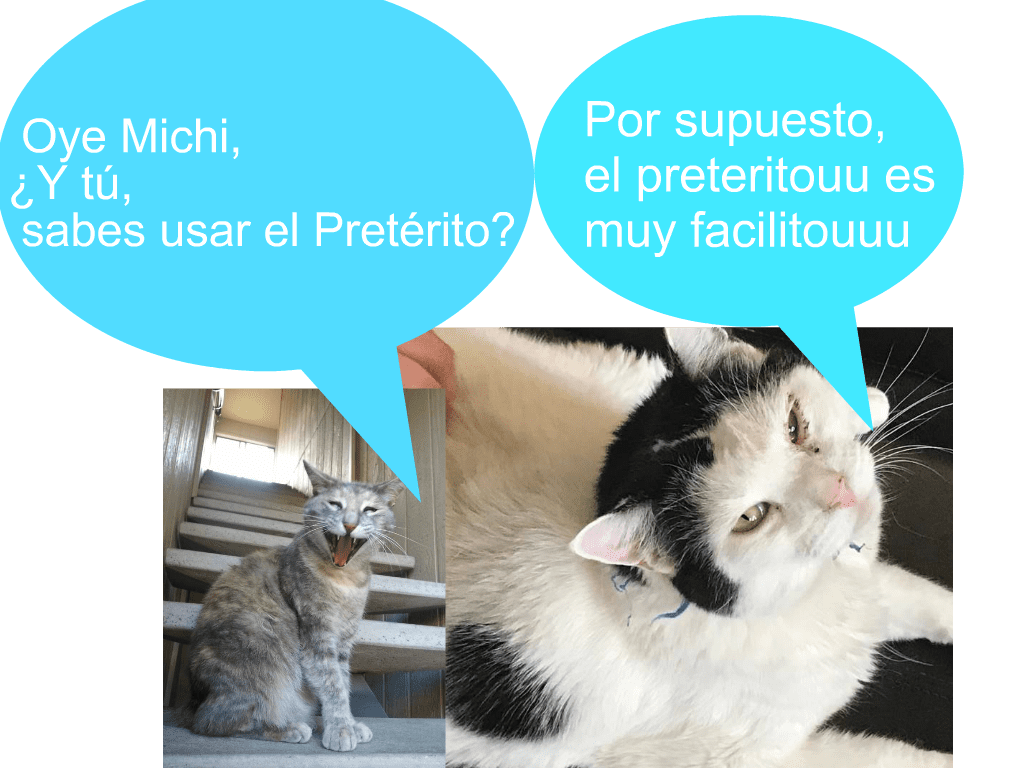One of your biggest nightmares in Spanish: The two ways of expressing the past tense in Spanish. (oh crapo)
My cat is bilingual! He meows and barks. Now he is learning to moo. He is soft, fluffy, and just starting to spread his wings—like a Phoenix.
 My cat’s name is Michi—mi gato se llama Michi—who acts like a dog. He’s transspecies, and barks too. You can say he’s a polyglot. For the record, a polyglot is NOT a new form of paraphilia diagnosed by the DSM-5 of the American Psychiatric Association (APA). Don’t force your imagination too much amig@s!
My cat’s name is Michi—mi gato se llama Michi—who acts like a dog. He’s transspecies, and barks too. You can say he’s a polyglot. For the record, a polyglot is NOT a new form of paraphilia diagnosed by the DSM-5 of the American Psychiatric Association (APA). Don’t force your imagination too much amig@s!
A polyglot is a person “or animal” that speaks multiple languages. And you could be one also if you start learning Spanish NOW! You can say words like “Chimichurri,” “Cucaracha,” or “Coco” correctly! Not “coucou.’ Just “Coco.”
Now that you’ve met Michi let’s discuss how he can teach us to use the past tense in Spanish!
Let’s learn the difference between the two types of simple past in Spanish. Yes, to make things more complicated, we, in Spanish, have two ways to express the past tense: Preterit and Imperfect.
 Both Preterit and Imperfect are actions that already finished in the past. It is just a different perception for each of both actions—in which one is specific, and the other one is more generic. Nevertheless, both are in the past!
Both Preterit and Imperfect are actions that already finished in the past. It is just a different perception for each of both actions—in which one is specific, and the other one is more generic. Nevertheless, both are in the past!
Preterit: In the Preterit, the emphasis is on (the) time. Preterit is used for a list of actions & for limited, complete, specific, consecutive, and interrupted actions which have occurred in the past.
 Let’s see the Preterit in action:
Let’s see the Preterit in action:
- In the following examples, we will see these two actions happening in the past but one after the other. Preterit is used to express both actions. Why? It is a list of actions or two consecutive actions, which—in this case—can be interpreted as cause-consequence for the well-known rivalry between dogs and cats.
- El perro maulló cuando el gato ladró.
- The dog meowed when the cat barked.
 Imperfect: In the Imperfect, the emphasis is on the action. Imperfect is used for characteristics & incomplete, generic, simultaneous, habitual, and continuous/progressive actions occurred in the past.
Imperfect: In the Imperfect, the emphasis is on the action. Imperfect is used for characteristics & incomplete, generic, simultaneous, habitual, and continuous/progressive actions occurred in the past.
Now the Imperfect in action:
- In the following examples, we will see these two actions happening at the same time. Imperfect is used with both verbs because they are two simultaneous actions in the past.
- El perro maullaba cuando el gato ladraba.
- The dog was meowing when the cat was barking.
Imperfect and Preterit: Sometimes it could be cool—and NECESSARY—to combine them if we want to express interruption of an action.
Now let’s see both the Imperfect and Preterit in action:
- In the following examples, we will see these two actions happening in the past, but one is in progress, and the other interrupts the first one. The action in progress is expressed by the Imperfect and the action interrupting the continuous action is expressed by the preterit. If you’re confused, it’s ok.
- El perro maullaba cuando el gato ladró.
- The dog was meowing when the cat barked.
 With Kasa De Franko you can learn about the complicated-simple past in Spanish and many other things. If you’re a cat, I can teach you how to speak like a dog, and if you’re a dog—I can show you how to climb trees to play with the cat!
With Kasa De Franko you can learn about the complicated-simple past in Spanish and many other things. If you’re a cat, I can teach you how to speak like a dog, and if you’re a dog—I can show you how to climb trees to play with the cat!
In my super-duper-fun lessons, I cover everything from Spanish vocabulary, conversational Spanish, and will tutor you to reach ultra-speedy rocket Spanish in no time. At Kasa De Franko, we teach you how to speak what matters to you: ¡La Cultura!
Forget learning empty phrases and things that have no value. I will not have you repeating the same phrase over and over until your tongue falls off, as you drool at the mouth, with your eyes cemented shut. No, no, no! I may even teach you a few “naughty” words. Either way, I assure you will learn TO THINK IN SPANISH, and speak it.
Learning Spanish online or in person will help you meet new people, increase job opportunities, and make you a better lover in the bedroom—so you can become the dog you’ve always dreamed of being. I mean a cat-dog-polyglot—a speaker of multiple languages!
 Don’t you think it’s time you embraced a little Latina cultura and merengued your way over to that hot and wild new “friend” who has got their eyes scanning up and down your body?
Don’t you think it’s time you embraced a little Latina cultura and merengued your way over to that hot and wild new “friend” who has got their eyes scanning up and down your body?
Yesssssssssss…
And when people ask you what animal you prefer, dogs or cats, you will say both! When they ask you if you’re more of a dog or cat person, you will say, I like cats AND dogs! So you could like both doggy and kitty style. Right? Or….¡También, claro, perro-gato en uno! OMG, it is literally raining cats and dogs now.
At Kasa De Franko, my mission is to enrich your life through language. People want to learn Spanish fast. As a Spanish Teacher in the Bay Area, my courses are ten times more efficient than what you’d get in a Spanish for Dummies book, guaranteed! Meow-ruff-mooooo.
Think in Spanish! Don’t just speak Spanish!
Embrace the Spanish Culture! Don’t just learn Spanish!


